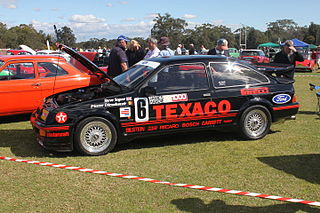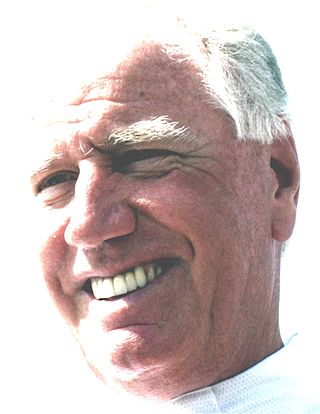Related Research Articles

Stone Brothers Racing (SBR) was an Australian motor racing team that competed in the International V8 Supercars Championship between 1998 and 2012. The team was formed in 1998 when Ross and Jim Stone bought Alan Jones's shares in Alan Jones Racing and renamed it Stone Brothers Racing.

Paul Morris Motorsport, also known as its business name of Nemo Racing, is an Australian motor racing team that competed in V8 Supercars between 2000 and 2012. The team also won the 1997 AMP Bathurst 1000 and four Australian Super Touring Championships. The team is based at the Norwell Motorplex in Norwell, Queensland and currently competes in the Super3 Series.

Rod Nash Racing is a Supercars Championship racing entity, owned by Rod Nash. Nash co-owns Tickford Racing and since 2018, Rod Nash Racing has run under the Tickford name.
Anthony Lawrence Longhurst is an Australian racing driver and former Australian Champion water skier. He is most noted for his career in the Australian Touring Car Championship and V8 Supercar series. Longhurst is a two-time winner of the Bathurst 1000, winning the event in 1988 with Tomas Mezera and in 2001 with Mark Skaife, and is one of only five drivers to win Bathurst in both a Ford and a Holden.
Gibson Motorsport was an Australian motor racing team that competed in the Australian Touring Car Championship from 1985 until 2003, though the team had its roots in Gibson's "Road & Track" team which ran a series of Ford Falcon GTHOs in Series Production during the late 1960s and early 1970s. The name of the team was also the name of Fred Gibson's automotive business in Sydney. As Gibson was also a driver for the Ford Works Team, his team was sometimes a pseudo-works team when the Ford factory did not enter.
Longhurst Racing was an Australian motor racing team that competed in the V8 Supercar series between 1995 and 1999.
Wayne Gardner Racing was an Australian motor racing team that competed in the Australian Touring Car Championship from 1994 until 1999.

Pierre Dieudonné is a Belgian auto racing driver and motoring journalist.

Neville Alexander Crichton is a New Zealand-born Australian businessman who was also a competitor in Australasian motor and yacht racing.
Bob Forbes Racing was an Australian motor racing team that competed in the Australian Touring Car Championship between 1988 and 1993.
Colin Bond Racing was an Australian motor racing team that competed in the Australian Touring Car Championship between 1984 and 1993.
M3 Motorsport was an Australian motor racing team that competed in Australian touring car racing between 1989 and 2003.
Playscape Racing was an Australian motor racing team that competed in Australian touring car racing between 1989 and 1998.
Eggenberger Motorsport was a Swiss motor racing team that competed in the European Touring Car Championship in the 1980s.
Pinnacle Motorsport was an Australian motor racing team that competed in Australian touring car racing in 1994 and 1995.
Volvo Dealer Racing, known originally as the Volvo Dealer Team and occasionally as Volvo 850 Racing, Volvo S40 Racing and Volvo Racing was an Australian motor racing team that debuted in 1994 competing in the Australian Production Car Championship and at the Bathurst 12 Hour before stepping up to the new Australian Super Touring Championship in 1995 and continued racing through to 1999.
Daily Planet Racing was an Australian motor racing team that competed in the Australian Touring Car Championship and V8 Supercars between 1992 and 2000.
Mark Petch Motorsport was a motor racing team that competed in Australian and New Zealand motorsport.
Greenfield Mowers Racing was a motor racing team that competed in Australia from the early 1990s until 2000.
Phil Ward Racing was an Australian motor racing team that competed in touring car racing between 1987 and 1995. The race team would later become the organisation that created and ran the Aussie Racing Cars series.
References
- 1 2 Greenhalgh, David; Howard, Graham; Wilson, Stewart (2011). The official history: Australian Touring Car Championship - 50 Years. St Leonards, New South Wales: Chevron Publishing Group. pp. 102–111. ISBN 978-0-9805912-2-4.
- ↑ Normoyle, Steve (1989). The Great Race 8. Hornsby: Chevron Publishing. ISSN 1031-6124.
- ↑ Normoyle, Steve (1990). The Great Race 9. Hornsby: Chevron Publishing. ISSN 1031-6124.
- ↑ Normoyle, Steve (1991). The Great Race 10. Hornsby: Chevron Publishing. ISSN 1031-6124.
- ↑ Introducing The Performance Driving Centre The Performance Driving Centre
- ↑ Normoyle, Steve (1992). The Great Race 11. Hornsby: Chevron Publishing. ISSN 1031-6124.
- ↑ Normoyle, Steve (1993). The Great Race 12. Hornsby: Chevron Publishing. ISSN 1031-6124.
- ↑ Greenhalgh, David; Tuckey, Bill (2013). The official history of The Great Race Bathurst : 50 years. St Leonards, New South Wales: Chevron Publishing Group. ISBN 9780980591231.
- ↑ Normoyle, Steve (1994). The Great Race 13. Hornsby: Chevron Publishing. ISSN 1031-6124.
- ↑ Normoyle, Steve (1995). The Great Race 14. Hornsby: Chevron Publishing. ISSN 1031-6124.
- ↑ Herrero, Daniel (11 October 2013). "Tony Longhurst limbering up for last lap". Speedcafe . Retrieved 23 March 2019.
- ↑ Normoyle, Steve (1995). The Great Race 15. Hornsby: Chevron Publishing. ISSN 1031-6124.